Abu Ghraib prison
The Abu Gurayb Prison, better known by the transliteration Abu Ghraib (in Arabic, سجن أبو غريب siŷn abū ġurayb ), was a prison located in Abu Ghraib, Iraq, built in the 1950s. After the invasion of Iraq, it became controlled by the United States and was finally returned to Iraqi hands. It has a capacity of between 13,000 and 14,000 prisoners.
After the 2003 invasion of Iraq, it was renamed "Camp Redemption", although it is better known by its original official name.[citation needed]. The prison was closed in 2014.
History
Under the US-led coalition
The prison houses more than 7,000 people, some accused of rebels, others accused of crimes, and others without charges. In the opinion of some UK officials, the prison should have been demolished, but this was vetoed by the US authorities.[citation needed]
In late April 2004, a US news channel exposed the torture, abuse and humiliation of Iraqi inmates by a group of US soldiers. The story included photographs, and has resulted in a major political scandal in the United States and other coalition countries. Subsequently, evidence of other similar abuses has emerged. These abuses of prisoners had been denounced, without response by the media and governments, by international humanitarian organizations such as Amnesty International, since the beginning of the occupation.
Human rights violations
In May 2004, a campaign to release prisoners began, to reduce their number to less than 2,000. In the same month, George W. Bush, President of the United States, announced that the prison would be demolished in agreement with the Iraqi authorities; the head of the Iraqi transitional government pointed out, however, that the prison would not be destroyed.
The commission of inquiry into the abuses at Abu Ghraib was created in May 2004 by defense secretary Donald Rumsfeld and was chaired by former defense secretary James Schlesinger.
The conclusions presented in his report were as follows:
- Indirect responsibility for the facts affects "to the entire chain of command to Washington"especially General Ricardo S. Sánchez, then head of U.S. troops in Iraq. They all knew what was going on, doing nothing to prevent it.
- The abuses were due to the sadism of the soldiers at night, not to something ordered or authorized by their superiors. They weren't part of the interrogations.
- More than 300 cases of abuse are still being investigated, some outside this prison.
The report does not recommend any type of punishment for those involved.
On the other hand, the US military is finalizing its own investigation, the results of which seem even more lurid.
Some American scientists and doctors apparently participated in the tortures at the Abu Ghraib or Abu Ghuraib prison. The American bioethicist Steven Miles writes in the scientific journal "The Lancet" that with this behavior they would be damaging ethical values of medicine and human rights. Miles, MD and professor at the University of Minnesota, is demanding an official investigation into the role of doctors in the torture scandal.
Miles relied on the protocols of the United States Congress and on the confessions of prisoners and soldiers, medical and press reports. A military spokesperson confirmed that most of the incidents and accusations described in the article were documented by the armed forces.
Miles writes that according to statements by US military officials, a psychiatrist and a doctor designed and approved the interrogation methods, as well as supervised the interrogations. He describes the case of a prisoner who under oath declares: the prisoner was beaten until he fell unconscious and was later treated by medical personnel and revived by them. They left and the prisoner was mistreated again.
A military police officer is further quoted by Miles as saying that a doctor injected a prisoner, who died from torture, with a substance to make it appear that he was still alive when taken for medical attention at the hospital. In Iraq and Afghanistan death certificates are falsified. "Doctors routinely confirm death from heart attack, heat stroke, and other natural causes of death," Miles writes. Only a few units in Iraq and Afghanistan would have made possible the monthly inspections required by the Geneva Convention, and the doctors also failed to provide regular medical attention to the prisoners.
Transfer to Iraqi Government
On March 9, 2006, the US military authorities decided to close the Abu Ghraib prison and transfer the detainees to other prisons in Iraq. In August 2006, it was reported that the prison was already empty and on September 2, the formal cession to the Iraqi government was made, which was announced by Ali al-Dabbagh, spokesman for Prime Minister Nouri al-Maliki. The ceremony was led by Major General Jack Gardner, Commander of Task Force 134, and representatives of the Ministry of Justice and the Iraqi Army.
Political consequences
November 9, 2006 Donald Rumsfeld, who in the words of David Ignatius of The Washington Post, is the figure who "symbolizes not only the failure of war, but also arrogance and lack of responsibility& #34; He was removed from the position of secretary of defense after the defeat of the Republican party in the legislative elections on November 7. On November 14, about twenty human rights associations represented by German lawyer Wolfgang Kaleck sued Rumsfeld and other US officials in the German Supreme Court or Generalbundesanwalt in Karlsruhe for war crimes.
Contenido relacionado
Doctor Guillermo Mann Base
Akranes
Battle of Raszyn
Barrios Unidos (Bogotá)
Fifth of Tilcoco



